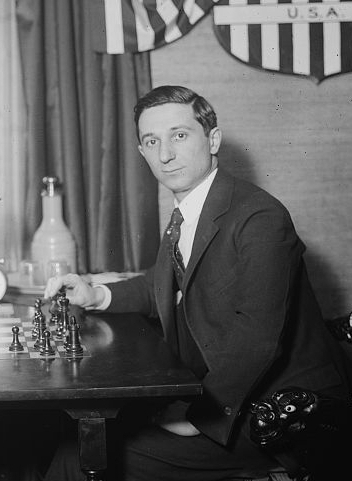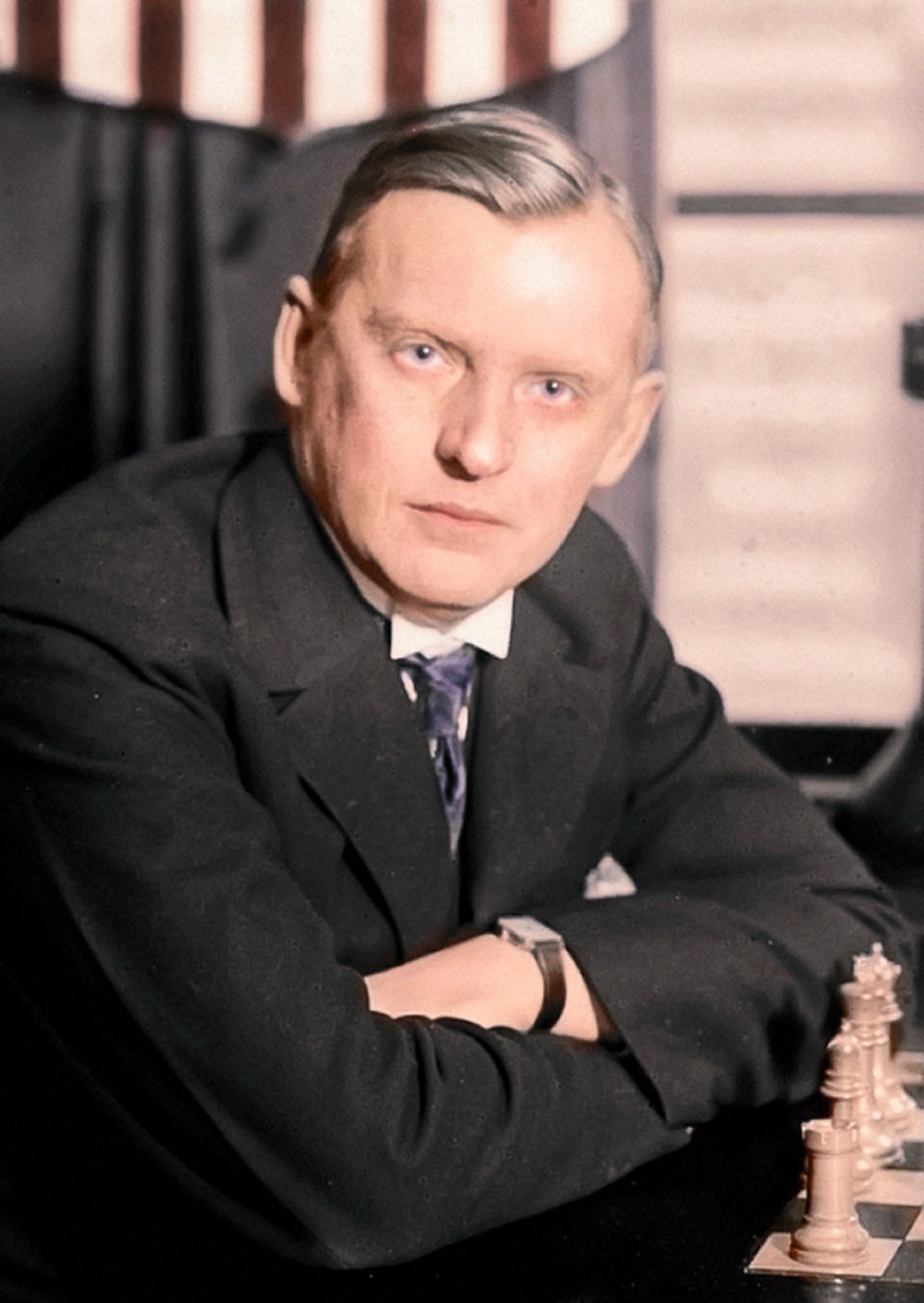After 1.e4 e5 2.Nf3 Black can spoil White's intentions to play the Ruy Lopez, the Scotch Game, the Giuoco Piano or the Evans Gambit by answering with 2. ... d6. In a first article on this topic I described that the former World Champion Alexander Alekhine (1892 - 1946) played the Philidor Defence several times and was very successful with it. Since the article met with lively interest and some ChessBase readers also provided interesting hints, I would like to go into some more details and present some more exciting games with this opening.
Edward Lasker vs Alekhine - a positional masterpiece
The 15-year-old Alexander Alekhine played an interesting game against Edward Lasker in Dusseldorf (Germany) in 1908. Again he chose the Hanham variation, in which Black defends e5 by 3. ... Nd7 instead of giving up the the centre by exchanging pawns or risking Philidor's hazardous counterattack 3. ... f5?!. Through skilful manoeuvring Alekhine reduced the white KB to an extra and won easily by sacrificing a knight to crush White's weakened King's flank.
In 1951, when his book "Chess Secrets" was published, Edward Lasker was still convinced that he could have beaten Alekhine if he had played dxe5 on move 6 and only then 7.Qb3. He wrote: "This is an example of how the transposition of two moves can turn a winning position into a losing one." (a) Should Alekhine really have made such a blunder in the opening?
You might consider such a thing when dealing with a player who cares little about opening theory. But Alekhine in particular was known for his good opening preparation, which certainly contributed a lot to his stunning victory in the 1927 World Championship match against the Cuban "chess machine" José Raul Capablanca. So let's ask ourselves: is the story of the winning position true?
Edward Lasker was completely wrong
In fact, the analysis of the position after the fifth move shows that Black need not be afraid of the move 6.dxe5. Alekhine would certainly not have carelessly played 6. ... dxe5?, but simply 6. ... Nxe4!. After that White cannot gain any advantage. The whole course of the game clearly shows how superior the only 15-year-old Alekhine was to his opponent, not only tactically but also strategically.
Edward Lasker (1885 - 1981) is the author of the well known book "Modern Chess Strategy" which was first published in Leipzig in 1911. When he was 92 years old he revised the text for the 9th edition (Berlin/New York 1978). Lasker, a distant relative of the World Champion Emanuel Lasker was from Germany, but in 1914 he emigrated to the United States and changed his first name from "Eduard" to "Edward".

Edward Lasker | Photo: Wikimedia
He won the US chess championship several times and was also one of the best American Go players. In 1913 Edward Lasker lost a little match with Alekhine by 0-3. The Russian also won two tournament games (Dusseldorf 1908 and Scheveningen 1913). Only in New York in 1924 Edward Lasker managed to draw both games against Alekhine.
Alekhine was also a brilliant rapid and blitz chess player
In his book "Chess Secrets" Edward Lasker described, how strongly Alekhine actually played at a young age. It was about an incident that took place a few days before their game, when the 16th Congress of the German Chess Federation hadn't yet started. The tournament was held in Dusseldorf in 1908 and the strong American grandmaster Frank James Marshall (1877 - 1944) had also been invited. Edward Lasker wrote:
When I arrived in Dusseldorf together with the other players from Berlin, the member of the reception committee waiting for us at the train station told us that Frank Marshall, the favourite for the Master's Tournament, was already in town and training with a young Russian student who had entered the main tournament. This 15-year-old seemed strong enough to give Marshall the odds of pawn and move, at least in rapid games. (...) [We] soon found out what kind of chess the boy actually played when we tackled him in some blitz games. He won them all. At that time his name did not mean much to us. But we were able to convince ourselves of his importance from chess headlines over the next thirty years. Because he was none other than Alexander Alexandrovich Alekhine. (a)

Alexander Alekine | Photo: Wikimedia
Alekhine's second loss with the Philidor
In my first article on the subject I had already mentioned Alekhine's loss against Carl Schlechter in the Master's Tournament of the 17th Congress of the German Chess Federation in Hamburg in 1910. Perhaps it's worth pointing out that Alekhine was 17 years old at the time. A young player may lose against the world no. 2, don't you think? A ChessBase reader drew my attention to a second loss by Alekhine with Philidor's Defence, which I had overlooked in the database, since it had come about through a transposition of moves via the Vienna Game (1.e4 e5 2.Nc3). It was not played in the autumn tournament of a Moscow chess club in 1907 as I first thought, but in a little match which the 15-year-old Alekhine lost to Vladimir Nenarokov in Moscow in 1908 by 0-3. Therefore Walter Korn was in fact right when he claimed that "Alekhine more than once experienced the worst" when he played the Philidor Defence. (b) It happened twice.
In any case Alekhine didn't lose because of the opening, for after 15 moves the game was still balanced. Then he unnecessarily allowed 17.Nxe5!. Nenarokov, however, didn't continue very well and was already worse after 19.... Bc4!. He then gambled by launching a daring sacrificial attack against the black King, which only succeeded because the young Alekhine didn't want to give up a second pawn for the piece he had won (23. ... Qb7!-/+). You can see from this that Nenarokov played still stronger than Alekhine in 1908.
IM Vladimir Nenarokov (1880 - 1953) won the Moscow Championship four times (in 1900, 1908, 1922 and 1924). Thanks to his four wins in 1908/1907 he was probably one of only a few chess players who had a plus score against Alekhine. Alekhine returned the favour some years later by defeating Nenarokov in Moscow in 1915 and again in 1918.
Alekhine revised his evaluation of the Philidor Defence
A ChessBase reader pointed out that in his book "My Best Games 1908 - 1923" Alekhine wrote the following about the Philidor Defence and especially the Hanham variation:
"I played it several times, too, but then I gave it up, as I came to the conclusion that it is insufficient against logical counterplay by White." (c)
Remember that opening theory is in a constant state of flux. Critical variations are constantly being refuted and strengthened again. That is why Alekhine's statement can only be regarded as temporary. Alekhine, too, modified his evaluation and after a temporary break began to play the opening again. In the Mega Database I found the following tournament games from Alekhine's later years in which he applied the Philidor Defence with the black pieces:
- Sir George Thomas vs Alexander Alekhine, Hastings 1933 (1/2 after 63 moves)
- Lajos Steiner vs Alexander Alekhine, Podebrady 1936 (0:1/30)
- Friedrich Saemisch vs Alexander Alekhine, Prague 1942 (1/2 after 43 moves)
- Jaromir Florian vs Alexander Alekhine, Prague 1943 (0:1/43)
Thus Alekhine scored 3 out of 4 (75%). In total I found 12 wins by Alekhine with the Philidor, two draws and only two losses.
Alekhine crushed IM Lajos Steiner
In the following game Alekhine provoked the Hungarian master Lajos Steiner by an early queen excursion and then even ventured to take an offered pawn. Tactical complications arose in which Steiner lost the thread. After only 30 moves he had to surrender in a hopeless position:
Lajos Steiner (1903 - 1975) was not a weak player. In Kecskemét in 1927 he finished second behind Alekhine (shared with GM Aaron Nimzovich). In 1936 he won the Hungarian championship. In 1939 he emigrated to Australia and won the Australian Championship several times. In two tournament games he held Alekhine to a draw (in Kecskemét in 1927 and at the 6th Chess Olympiad in Warsaw in 1935), but four other games were all won by Alekhine.
Opening theory will continue to change in the future
The fact that opening theory is constantly changing can also easily be illustrated by the following circumstance: in the three other tournament games mentioned above Alekhine played 3. ... Nd7 immediately after 1.e4 e5 2.Sf3 d6 3.d4, although in his book "My Best Games 1908 - 1923" he had recommended the move order 3. ... Nf6 4.Nc3 Nbd7. On 3. ... Nf6 he wrote: "This move, introduced into tournament play by Nimzovich, is not without reason considered stronger than 3. ... Nd7." (d) So here again a re-evaluation had taken place and Alekhine had come to the conclusion that you need not play 3. ... Nf6 first. Anyone who wants to play the Philidor Defence as part of his or her opening repertoire should therefore keep up to date and consider what the latest theory recommends.
The modern form of the Philidor Defence arises via the move order 1.e4 d6 2.d4 Nf6 3.Nc3 e5. Then after 4.Nf3 Nbd7, Shirov has introduced the pawn sacrifice 5.g4!? into practice — and achieved excellent results with it.
Everything worth knowing about World Champion Alexander Alekhine can be found in the following DVD:
On this DVD GMs Rogozenco, Marin, Müller, and IM Reeh present outstanding games, stunning combinations and exemplary endgames by Alekhine. And they invite you to improve your knowledge with the help of video lectures, annotated games and interactive tests
The Mega Database contains almost all known games played by Edward Lasker, Vladimir Nenarokov, Lajos Steiner and Alexander Alekhine.
The ChessBase Mega Database 2021 is the premiere chess database with over 8.4 million games from 1560 to 2020 in high quality.
References:
(a) Some excerpts from Edward Lasker's book "Chess Secrets - I Learned From The Masters" were translated by Wolf-Dieter Raschke (http://www.schach-starter.de/Schach-Biografien.html). As I do not own the English edition I had to retranslate the text from the German version.
(b) Walter Korn, "Moderne Schacheröffnungen" (Modern Chess Openings), first German edition, Hamburg 1967, p. 112. IGM Larry Evans must be considered as a co-author, because the German version was based on his English edition.
(c) Alexander Aljechin (Alekhine), "Meine besten Partien 1908 – 1923", 3rd edition, Berlin/New York 1978, p. 26/27.
(d) Alexander Aljechin (Alekhine), "Meine besten Partien 1908 – 1923", 3rd edition, Berlin/New York 1978, p.109.
Links

























